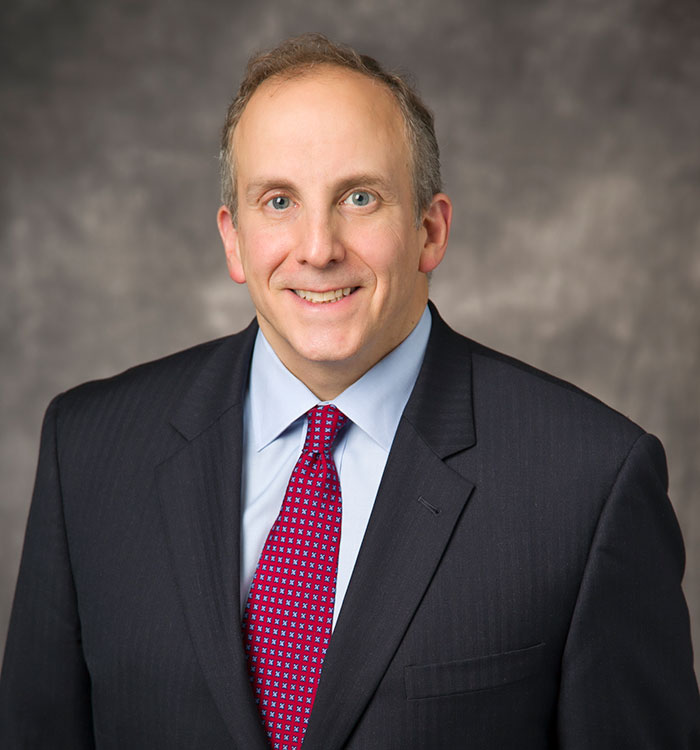UH Neurosurgeon Testing Novel Gene Therapy Treatment for Glioblastoma
June 19, 2019
New $2.7 million grant from the National Cancer Institute will help validate promising approach
Innovations in Cancer | Summer 2019
 Andrew Sloan, MD
Andrew Sloan, MDGlioblastoma multiforme (GBM) remains one of the most difficult cancers to treat, with mean survival of only about a year. However, a novel gene therapy clinical trial at UH Seidman Cancer Center and the Case Comprehensive Cancer Center is showing promising results and has been funded by the National Cancer Institute with a prestigious U01 grant. Median survival of GBM patients in the Phase 1 portion of the trial – initially designed simply to assess safety rather than to assess clinical benefit -- was 3.5 times the expected survival based on case-controlled data from published randomized clinical trials.
Andrew E. Sloan, MD, Director of the Brain Tumor & Neuro-Oncology Center and the Center of Excellence for Translational Neuro-Oncology (CETNO) at UH Cleveland Medical Center and UH Seidman Cancer Center; and Professor of Neurosurgery, Case Western Reserve University School of Medicine, along with Stan Gerson, MD, Director of the Case Comprehensive Cancer Center, recently learned that their $2.7 million grant from the National Cancer Institute to further their studies of gene therapy and GBM will be funded.
Their trial centers on the role of the chemotherapeutic agents O-benzylguanine (BG) and temozolomide (TMZ) and the repair enzyme MGMT, known to be an important prognostic indicator in GBM. It is limited to the poor prognosis GBM patients -- those with unmethylated MGMT.
“Patients who have a big carbon group blocking the MGMT enzyme are said to be ‘methylated’ and comprise the ‘good prognosis’ group. They don’t make much MGMT, and chemo and the radiation work great,” Dr. Sloan says. “Those patients do better--almost 50 percent of them live for two years. However, about 55 percent of patients don’t have that feature – they are unmethylated and make lots of MGMT, which protects the tumor from chemotherapy. They comprise the ‘poor prognosis’ group with a median two-year survival of only 13.8 months. That’s where we’ve been since 2005.”
“Several years ago, we began to wonder if we could convert patients from ‘poor prognosis’ to ‘good prognosis’ by inhibiting MGMT with BG.”
Previous studies had shown that while BG does effectively inhibit MGMT, it causes an unacceptable amount of bone marrow side effects.
“BG has two different effects – one makes the brain tumor respond to chemo,” Dr. Sloan says. “But the other damages the bone marrow. What if we could separate those two populations and treat them as different compartments in the body?”
This, Dr. Sloan says, led to the idea of using gene therapy to alter MGMT.
“Stan Gerson has been working on MGMT for 30 years and is the world expert,” Dr. Sloan says. “GBM is the one cancer where it really makes a difference!”
Dr. Gerson developed a mutant gene called P140K, which does not bind BG. Dr. Sloan then gathered hematopoietic stem cells from patients’ own blood through leukapheresis, genetically engineered them with P140K to make them resistant to chemotherapy, and then re-infused them to protect the bone marrow.
Importantly, the gene therapy was done with a new lentiviral vector rather than a retrovirus, as in other gene therapy studies.
“The retroviral gene inserts itself into the genome randomly, which has sometimes caused serious side-efficts,” Dr. Sloan says. “Conversely, the lentiviral vector is not random, so we thought there would be a very low risk of insertional mutagenesis ”
Results to date have been promising.
“We’ve had very few side effects,” he says. “All eligible patients tolerated at least one cycle of progressively increased dosage of chemotherapy. The median number of cycles of dose escalation of BG and TMZ tolerated was five. Median survival was 3.5 fold longer than expected, and the MGMT mutant was 3 to 26 times higher in peripheral blood than in untreated patients.”
“This regimen was tolerable, safe, and enabled dose escalation of chemotherapy with impressive improvement in survival compared to a large set of case-matched studies,” Dr. Sloan adds. “These highly encouraging results convinced the NCI to fund the U01, thus driving the protocol into a multi-center Phase II clinical trial.”
One important question, Dr. Sloan says, is how best to sequence surgery, radiation, chemotherapy and the reinfusion of genetically engineered stem cells. The Phase I trial tested three possible sequences and found that the first and third cohorts of patients did better than the second cohort. Remarkably, three of five patients in cohort three have no disease recurrence after three years, with two patients still disease free at 4.2-fold or more the expected survival.
Another question to be explored with the new NCI funding is why and how the tumor eventually grew back in some patients.
“Are there some patients who are more likely to benefit than others?” asks Dr. Sloan. “The more you can identify the patients who are likely to benefit, the better. We suspect this may be an immune phenomenon, so we want to explore interactions with the immune system further in the Phase II trial.”


